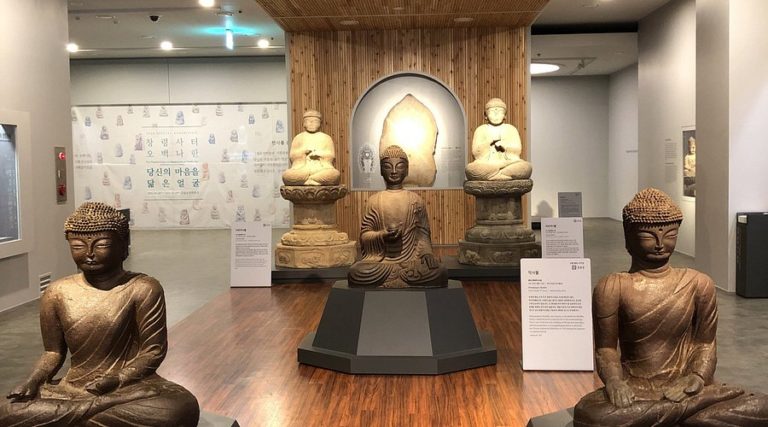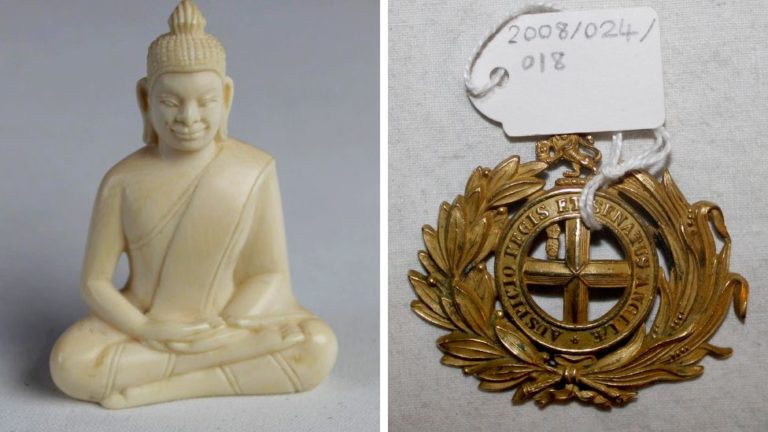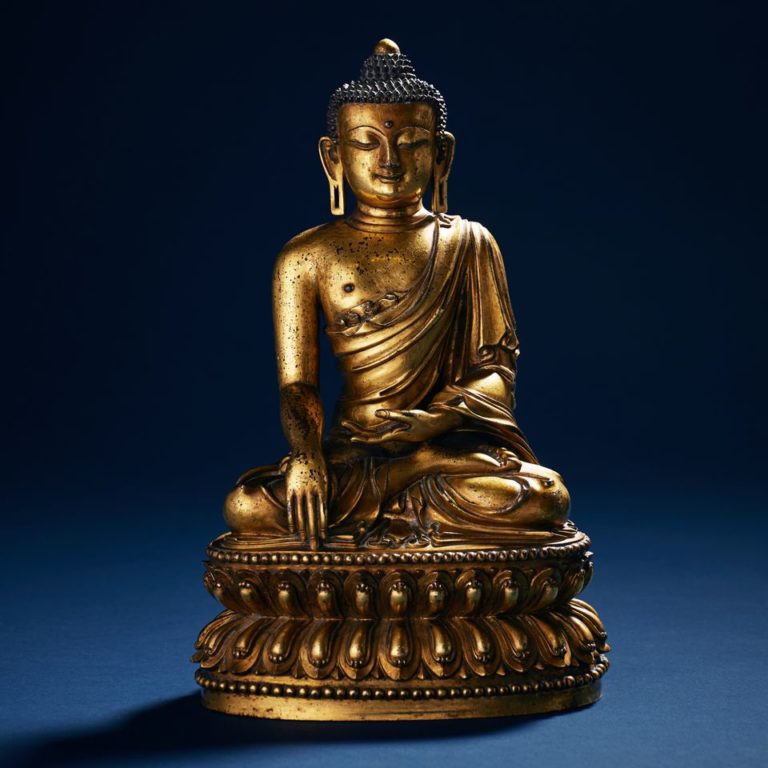A piece at the entrance to “Across Asia: Arts of Asia and the Islamic World” encapsulates this recently revamped floor of the Walters Art Museum: A Chinese porcelain vessel dating to about 1720, most likely a vase, has been incorporated into a narghile, or water pipe, that was fashioned with gilded silver, copper alloy, rubies and emeralds in the 19th-century Ottoman Empire.

“This narghile has an early Qing Dynasty blue-and-white in the middle of this incredibly ornamented hookah,” says Adriana Proser, the museum’s chief curator of Asian art. “It really shows how treasured Chinese porcelains were during the Ottoman Empire.”
It’s an example of the cultural interactions and interconnectivity that the museum has emphasized in completely reconceiving its Asian and Islamic galleries after more than a decade since it last did so, in a new permanent section showcasing about 550 pieces. About 50 are on view at the Walters for the first time, thanks to recent conservation efforts and larger, redesigned exhibition spaces.
The galleries are organized around three broad geographic areas — Southeast Asia, South Asia and the Islamic world — with both the layout and exhibits underscoring “how these influences, religions, traditions were flowing from one place to another,” as Proser puts it. They are further divided to focus on subregions, including Japan and Korea; materials, like ceramics; and categories, such as weaponry.
Displays highlight strengths of the museum’s collection, including ceramics from China’s Qing Dynasty, art from Meiji-era Japan, and sculptures and other representations of the Buddha and bodhisattvas. A wooden Buddha from China dated to about A.D. 590 is one of the oldest known lacquer Buddhas in the world; in the back is a hollow cavity that would have been used to hold sacred scrolls. A top draw in the Islamic section is the dazzling gun of Ottoman Sultan Mahmud I: The work of both Muslim and Armenian artisans, it is decorated with over 3,000 gemstones and contains hidden compartments for a dagger and writing implements.
Several cases examine the role of stimulants across the region and the richly decorated objects created for their use, sharing and storage, including Japanese tobacco pipes; Chinese and Mongolian snuff bottles; teapots and serving vessels from several cultures; and Indonesian implements used with betel quid, a mixture of ingredients that is chewed like tobacco.
Of what’s newly on view, the standout is a thammat, or pulpit, from a 19th-century Thai Buddhist temple — one of the only known examples of its kind in a U.S. museum. The 12-foot-high wooden structure, made with hundreds of gilded glass pieces that glitter like metal, is in the form of a miniature temple. Its ornate design suggests it was donated to a temple by a member of the royal family.
Originally acquired by heiress and art collector Doris Duke in the 1950s or ’60s, the thammat was a gift from Duke’s foundation in 2002, but the Walters had been unable to display it. “It was in over 100 pieces,” Proser says. “Nobody had recorded how things were originally pieced together. So it was like a big puzzle” for conservators, who spent hundreds of hours refurbishing and reconstructing it. A time-lapse video reveals how it was done.
Curators consulted with the Wat Thai Washington, D.C., temple in Silver Spring to help contextualize the thammat, and visitors can watch a video of one of the monks, Thanat Inthisan, reciting from the Jataka tales of the Buddha’s past lives. The video is part of a new commitment by the museum to incorporate community voices to demonstrate how these works connect to local communities, rather than being mere historical artifacts.
The Islamic galleries — encompassing ceramics, metalwork, jewelry and manuscripts including Qurans — similarly aim to draw linkages with living cultures and real people, as well as illustrating the diversity of art and objects that tend to be grouped under the umbrella of a religion while often not being religious in nature.
“So often, displays of Islamic art kind of perpetuate this idea of Islam as this monolith,” says Ashley Dimmig, a guest curator and former postdoctoral fellow who worked on the reinstallation, “when in reality, Islamic art is a global art, and is incredibly diverse over one and a half millennia.”
Opening the section is a tile from 17th-century Iznik, a major Ottoman ceramics center, that diagrams the Great Mosque in Mecca, with the Kaaba at its center. A panel next to it tells the story of Omar ibn Said, a Senegalese-born Muslim scholar who was enslaved in the United States in the 19th century and wrote an Arabic-language autobiography, which mentioned his having made the pilgrimage to Mecca. While the juxtaposition might at first seem slightly incongruous, it makes a nice
case for cultural linkages across time and space.
The museum also highlights contemporary artists with ties to these cultures. Alongside a folding album of calligraphy by Ottoman Turkish master calligrapher Seyh Hamdullah, who died in 1520, is a 2017 example by Mohamed Zakariya, an American Muslim calligrapher based in Arlington who has carried on Hamdullah’s tradition. A stunning 2018 mixed-media painting by Iranian-born American artist Arghavan Khosravi that incorporates an image of an ‘alam, or Shiite processional standard, hangs across from an actual iron and steel ‘alam made in Iran in roughly 1664.
Although the “Across Asia” galleries are permanent, some of the more sensitive textiles and works on paper will be regularly swapped out with other items. Most of the contemporary art is on loan and will likewise be replaced by other pieces in the future. Thus, just as the arts of Asia and the Islamic world are presented as expansive and dynamic, so will these galleries change over time, rewarding the repeat visitor.
If you go
Across Asia: Arts of Asia and the Islamic World
Walters Art Museum, 600 N. Charles St., Baltimore. 410-547-9000. thewalters.org.
Dates: On long-term view.
Prices: Free
By Vanessa LarsonVanessa H. Larson




